Vodafone Group Business Strategy Analysis Report: PESTEL and VRIO
VerifiedAdded on 2020/11/23
|13
|4796
|135
Report
AI Summary
This report provides a comprehensive analysis of Vodafone's business strategy, examining the impact of the macro-environment through PESTEL analysis, the internal environment using the VRIO model, and the competitive market using Porter's Five Forces. The report delves into Vodafone's strategic capabilities, strengths, and weaknesses, and explores strategic directions and options using Porter's generic model and the Ansoff matrix. The PESTEL analysis covers political, economic, social, technological, legal, and environmental factors affecting Vodafone. The VRIO model assesses the value, rarity, imitability, and organization of Vodafone's resources and capabilities. The report highlights Vodafone's brand image, customer satisfaction, and skilled workforce as key strengths. The Ansoff matrix is used to understand market penetration, product development, market development, and diversification strategies. The analysis aims to provide insights into Vodafone's strategic positioning and potential for future growth in the telecommunications industry.
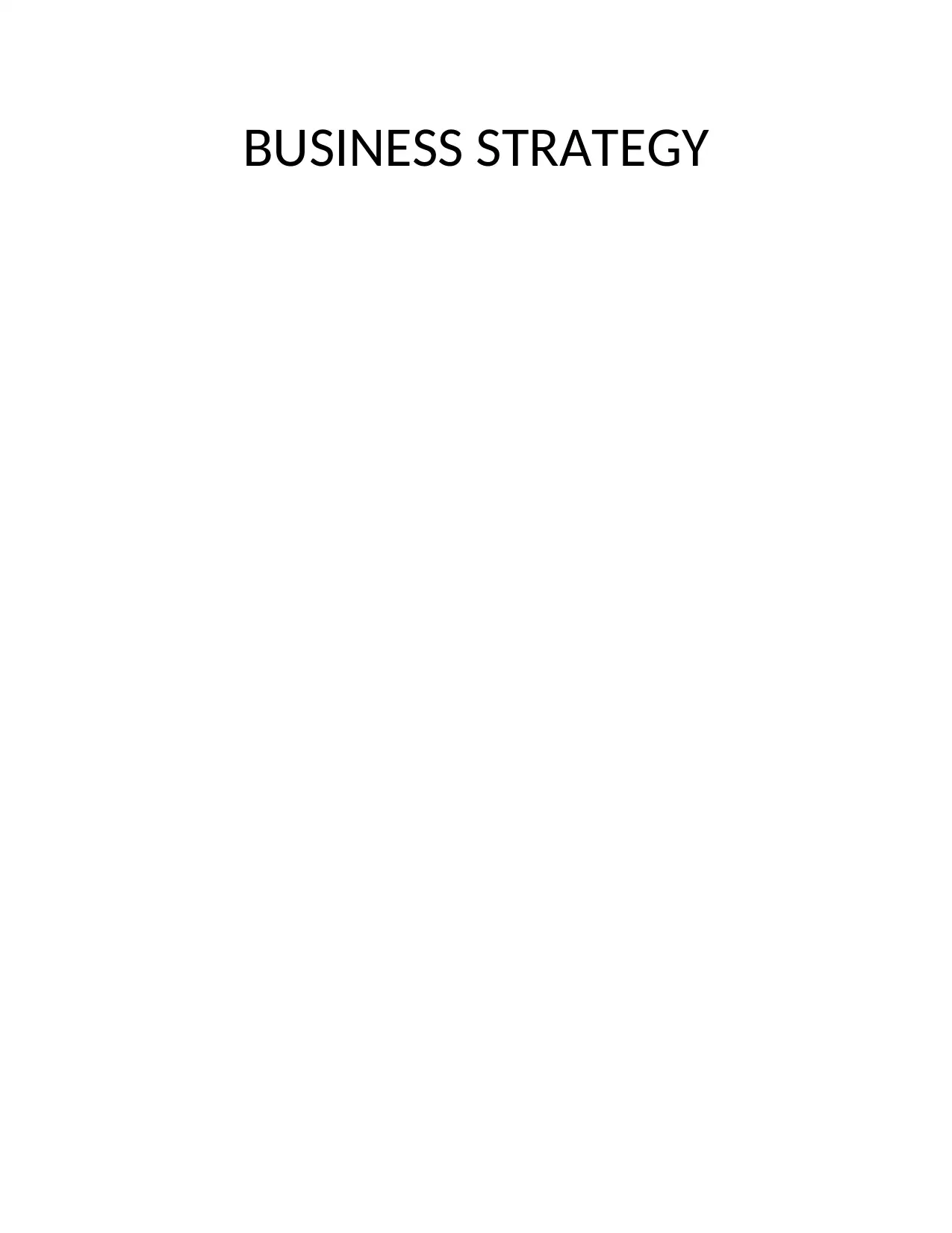
BUSINESS STRATEGY
Paraphrase This Document
Need a fresh take? Get an instant paraphrase of this document with our AI Paraphraser

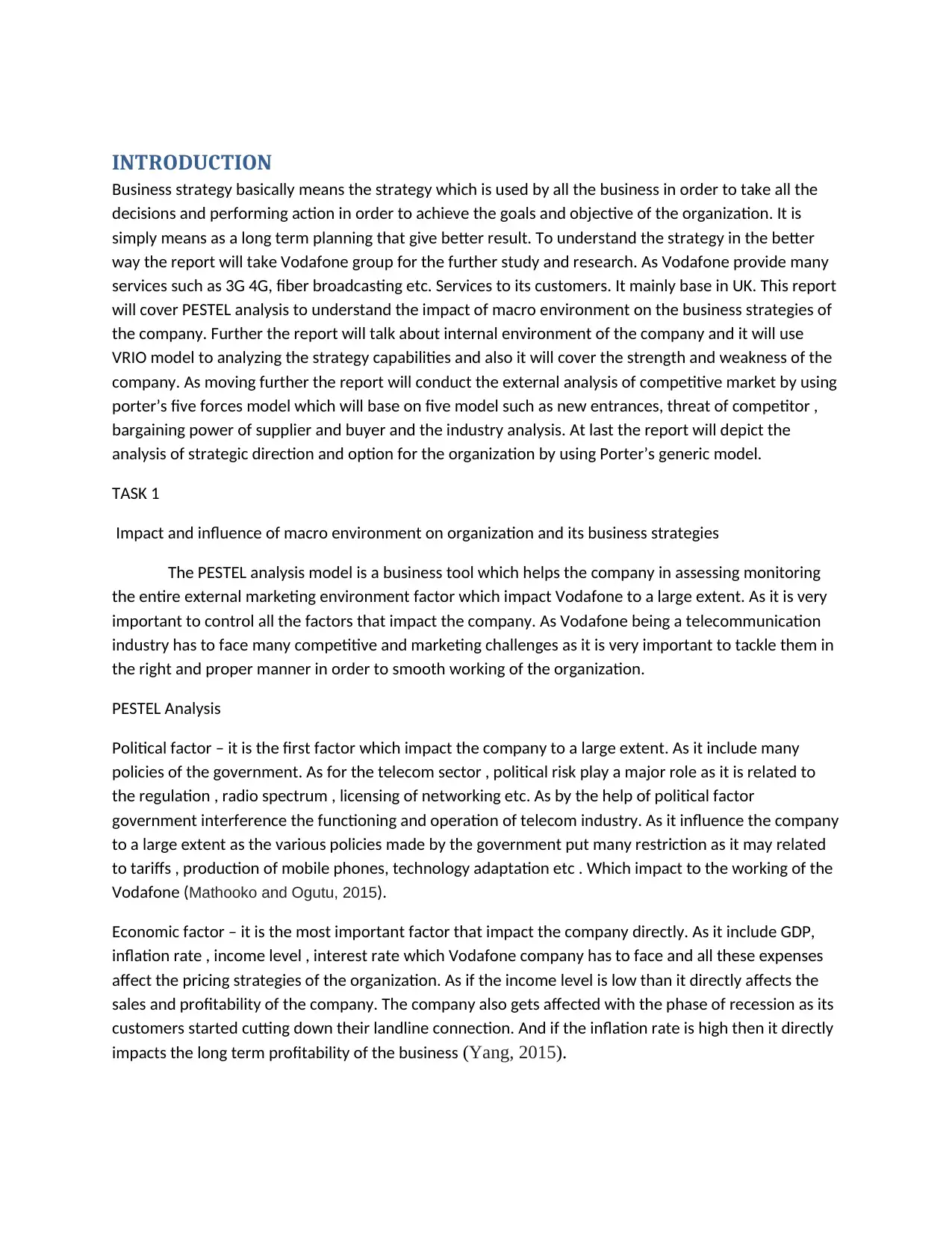
INTRODUCTION
Business strategy basically means the strategy which is used by all the business in order to take all the
decisions and performing action in order to achieve the goals and objective of the organization. It is
simply means as a long term planning that give better result. To understand the strategy in the better
way the report will take Vodafone group for the further study and research. As Vodafone provide many
services such as 3G 4G, fiber broadcasting etc. Services to its customers. It mainly base in UK. This report
will cover PESTEL analysis to understand the impact of macro environment on the business strategies of
the company. Further the report will talk about internal environment of the company and it will use
VRIO model to analyzing the strategy capabilities and also it will cover the strength and weakness of the
company. As moving further the report will conduct the external analysis of competitive market by using
porter’s five forces model which will base on five model such as new entrances, threat of competitor ,
bargaining power of supplier and buyer and the industry analysis. At last the report will depict the
analysis of strategic direction and option for the organization by using Porter’s generic model.
TASK 1
Impact and influence of macro environment on organization and its business strategies
The PESTEL analysis model is a business tool which helps the company in assessing monitoring
the entire external marketing environment factor which impact Vodafone to a large extent. As it is very
important to control all the factors that impact the company. As Vodafone being a telecommunication
industry has to face many competitive and marketing challenges as it is very important to tackle them in
the right and proper manner in order to smooth working of the organization.
PESTEL Analysis
Political factor – it is the first factor which impact the company to a large extent. As it include many
policies of the government. As for the telecom sector , political risk play a major role as it is related to
the regulation , radio spectrum , licensing of networking etc. As by the help of political factor
government interference the functioning and operation of telecom industry. As it influence the company
to a large extent as the various policies made by the government put many restriction as it may related
to tariffs , production of mobile phones, technology adaptation etc . Which impact to the working of the
Vodafone (Mathooko and Ogutu, 2015).
Economic factor – it is the most important factor that impact the company directly. As it include GDP,
inflation rate , income level , interest rate which Vodafone company has to face and all these expenses
affect the pricing strategies of the organization. As if the income level is low than it directly affects the
sales and profitability of the company. The company also gets affected with the phase of recession as its
customers started cutting down their landline connection. And if the inflation rate is high then it directly
impacts the long term profitability of the business (Yang, 2015).
Business strategy basically means the strategy which is used by all the business in order to take all the
decisions and performing action in order to achieve the goals and objective of the organization. It is
simply means as a long term planning that give better result. To understand the strategy in the better
way the report will take Vodafone group for the further study and research. As Vodafone provide many
services such as 3G 4G, fiber broadcasting etc. Services to its customers. It mainly base in UK. This report
will cover PESTEL analysis to understand the impact of macro environment on the business strategies of
the company. Further the report will talk about internal environment of the company and it will use
VRIO model to analyzing the strategy capabilities and also it will cover the strength and weakness of the
company. As moving further the report will conduct the external analysis of competitive market by using
porter’s five forces model which will base on five model such as new entrances, threat of competitor ,
bargaining power of supplier and buyer and the industry analysis. At last the report will depict the
analysis of strategic direction and option for the organization by using Porter’s generic model.
TASK 1
Impact and influence of macro environment on organization and its business strategies
The PESTEL analysis model is a business tool which helps the company in assessing monitoring
the entire external marketing environment factor which impact Vodafone to a large extent. As it is very
important to control all the factors that impact the company. As Vodafone being a telecommunication
industry has to face many competitive and marketing challenges as it is very important to tackle them in
the right and proper manner in order to smooth working of the organization.
PESTEL Analysis
Political factor – it is the first factor which impact the company to a large extent. As it include many
policies of the government. As for the telecom sector , political risk play a major role as it is related to
the regulation , radio spectrum , licensing of networking etc. As by the help of political factor
government interference the functioning and operation of telecom industry. As it influence the company
to a large extent as the various policies made by the government put many restriction as it may related
to tariffs , production of mobile phones, technology adaptation etc . Which impact to the working of the
Vodafone (Mathooko and Ogutu, 2015).
Economic factor – it is the most important factor that impact the company directly. As it include GDP,
inflation rate , income level , interest rate which Vodafone company has to face and all these expenses
affect the pricing strategies of the organization. As if the income level is low than it directly affects the
sales and profitability of the company. The company also gets affected with the phase of recession as its
customers started cutting down their landline connection. And if the inflation rate is high then it directly
impacts the long term profitability of the business (Yang, 2015).
⊘ This is a preview!⊘
Do you want full access?
Subscribe today to unlock all pages.

Trusted by 1+ million students worldwide
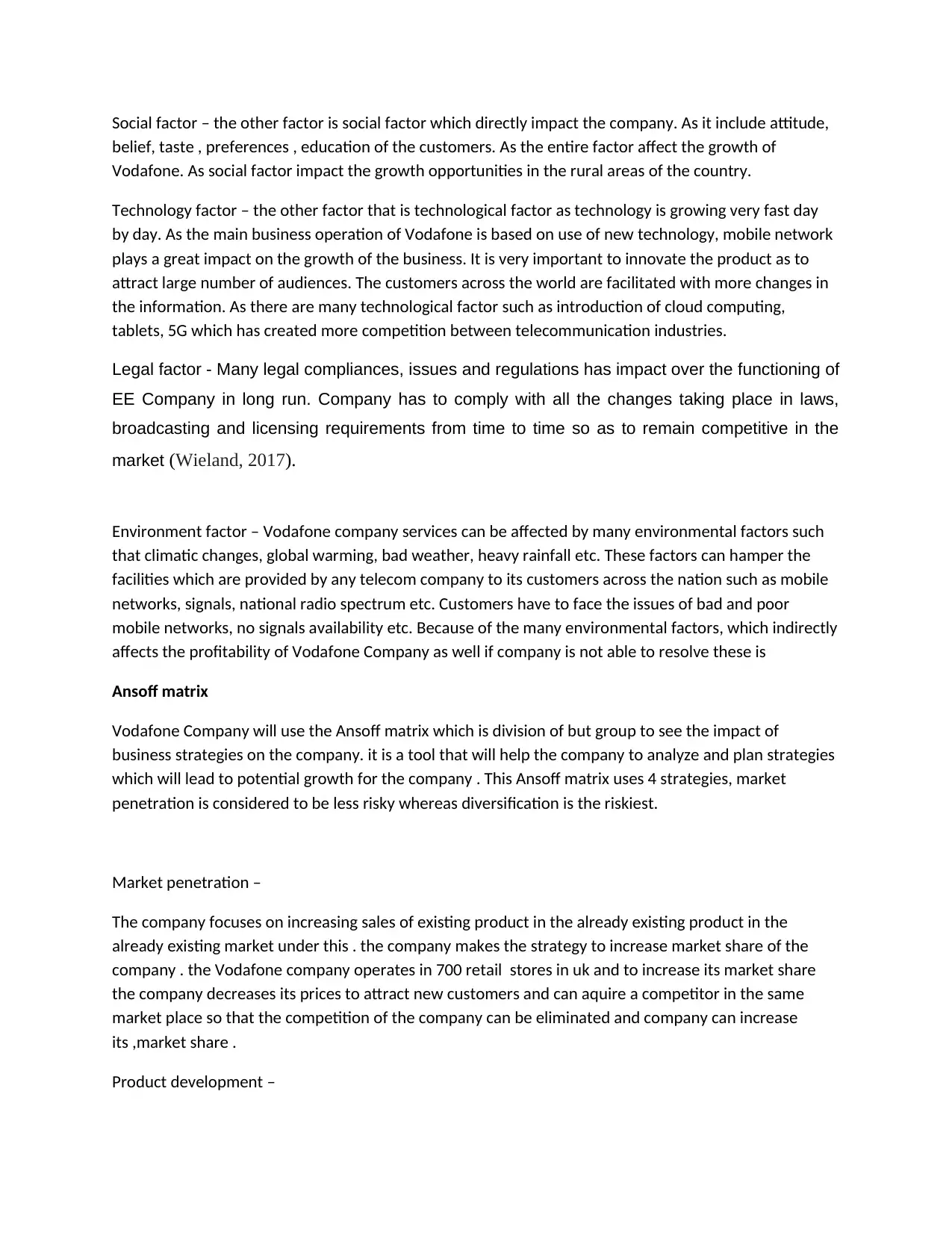
Social factor – the other factor is social factor which directly impact the company. As it include attitude,
belief, taste , preferences , education of the customers. As the entire factor affect the growth of
Vodafone. As social factor impact the growth opportunities in the rural areas of the country.
Technology factor – the other factor that is technological factor as technology is growing very fast day
by day. As the main business operation of Vodafone is based on use of new technology, mobile network
plays a great impact on the growth of the business. It is very important to innovate the product as to
attract large number of audiences. The customers across the world are facilitated with more changes in
the information. As there are many technological factor such as introduction of cloud computing,
tablets, 5G which has created more competition between telecommunication industries.
Legal factor - Many legal compliances, issues and regulations has impact over the functioning of
EE Company in long run. Company has to comply with all the changes taking place in laws,
broadcasting and licensing requirements from time to time so as to remain competitive in the
market (Wieland, 2017).
Environment factor – Vodafone company services can be affected by many environmental factors such
that climatic changes, global warming, bad weather, heavy rainfall etc. These factors can hamper the
facilities which are provided by any telecom company to its customers across the nation such as mobile
networks, signals, national radio spectrum etc. Customers have to face the issues of bad and poor
mobile networks, no signals availability etc. Because of the many environmental factors, which indirectly
affects the profitability of Vodafone Company as well if company is not able to resolve these is
Ansoff matrix
Vodafone Company will use the Ansoff matrix which is division of but group to see the impact of
business strategies on the company. it is a tool that will help the company to analyze and plan strategies
which will lead to potential growth for the company . This Ansoff matrix uses 4 strategies, market
penetration is considered to be less risky whereas diversification is the riskiest.
Market penetration –
The company focuses on increasing sales of existing product in the already existing product in the
already existing market under this . the company makes the strategy to increase market share of the
company . the Vodafone company operates in 700 retail stores in uk and to increase its market share
the company decreases its prices to attract new customers and can aquire a competitor in the same
market place so that the competition of the company can be eliminated and company can increase
its ,market share .
Product development –
belief, taste , preferences , education of the customers. As the entire factor affect the growth of
Vodafone. As social factor impact the growth opportunities in the rural areas of the country.
Technology factor – the other factor that is technological factor as technology is growing very fast day
by day. As the main business operation of Vodafone is based on use of new technology, mobile network
plays a great impact on the growth of the business. It is very important to innovate the product as to
attract large number of audiences. The customers across the world are facilitated with more changes in
the information. As there are many technological factor such as introduction of cloud computing,
tablets, 5G which has created more competition between telecommunication industries.
Legal factor - Many legal compliances, issues and regulations has impact over the functioning of
EE Company in long run. Company has to comply with all the changes taking place in laws,
broadcasting and licensing requirements from time to time so as to remain competitive in the
market (Wieland, 2017).
Environment factor – Vodafone company services can be affected by many environmental factors such
that climatic changes, global warming, bad weather, heavy rainfall etc. These factors can hamper the
facilities which are provided by any telecom company to its customers across the nation such as mobile
networks, signals, national radio spectrum etc. Customers have to face the issues of bad and poor
mobile networks, no signals availability etc. Because of the many environmental factors, which indirectly
affects the profitability of Vodafone Company as well if company is not able to resolve these is
Ansoff matrix
Vodafone Company will use the Ansoff matrix which is division of but group to see the impact of
business strategies on the company. it is a tool that will help the company to analyze and plan strategies
which will lead to potential growth for the company . This Ansoff matrix uses 4 strategies, market
penetration is considered to be less risky whereas diversification is the riskiest.
Market penetration –
The company focuses on increasing sales of existing product in the already existing product in the
already existing market under this . the company makes the strategy to increase market share of the
company . the Vodafone company operates in 700 retail stores in uk and to increase its market share
the company decreases its prices to attract new customers and can aquire a competitor in the same
market place so that the competition of the company can be eliminated and company can increase
its ,market share .
Product development –
Paraphrase This Document
Need a fresh take? Get an instant paraphrase of this document with our AI Paraphraser
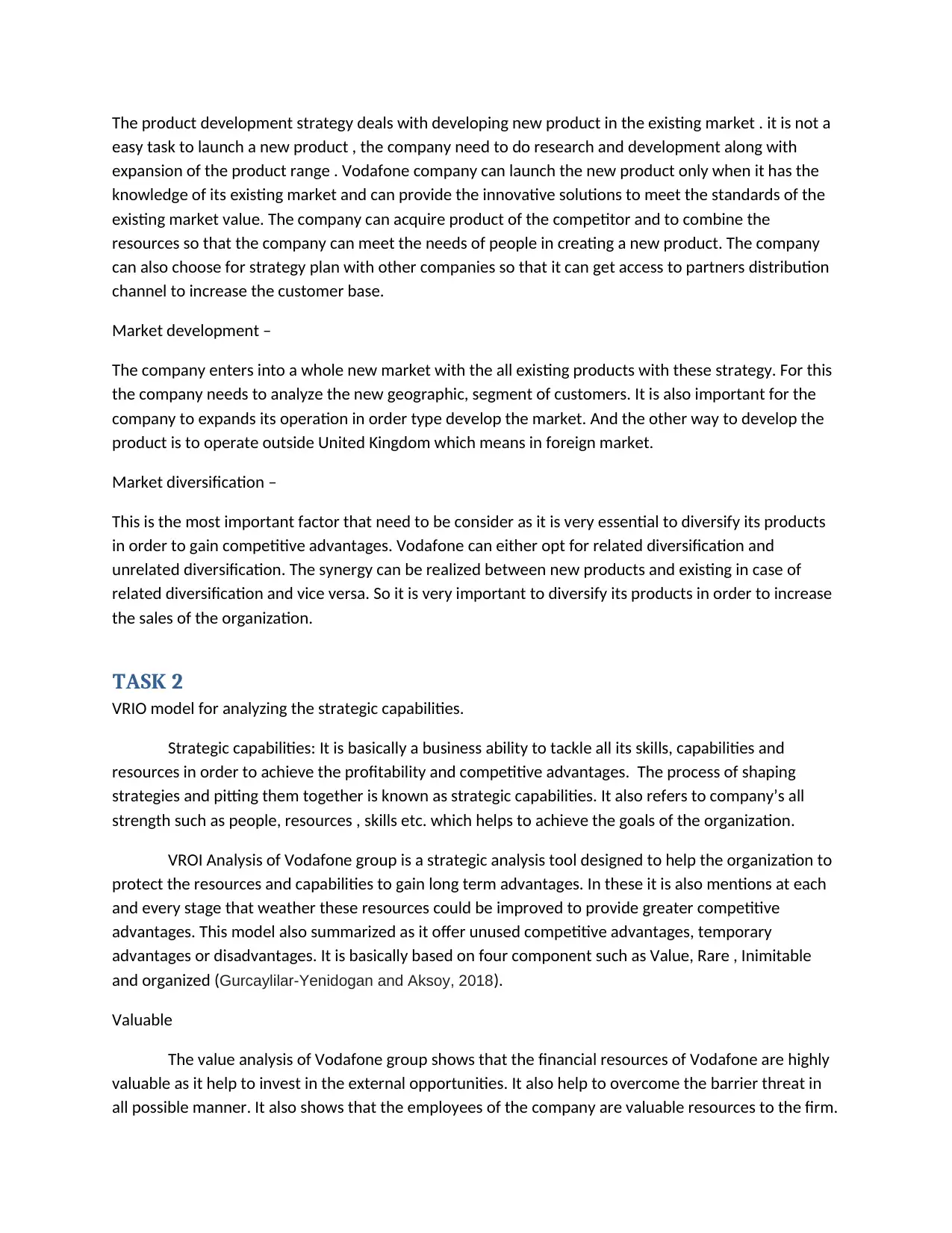
The product development strategy deals with developing new product in the existing market . it is not a
easy task to launch a new product , the company need to do research and development along with
expansion of the product range . Vodafone company can launch the new product only when it has the
knowledge of its existing market and can provide the innovative solutions to meet the standards of the
existing market value. The company can acquire product of the competitor and to combine the
resources so that the company can meet the needs of people in creating a new product. The company
can also choose for strategy plan with other companies so that it can get access to partners distribution
channel to increase the customer base.
Market development –
The company enters into a whole new market with the all existing products with these strategy. For this
the company needs to analyze the new geographic, segment of customers. It is also important for the
company to expands its operation in order type develop the market. And the other way to develop the
product is to operate outside United Kingdom which means in foreign market.
Market diversification –
This is the most important factor that need to be consider as it is very essential to diversify its products
in order to gain competitive advantages. Vodafone can either opt for related diversification and
unrelated diversification. The synergy can be realized between new products and existing in case of
related diversification and vice versa. So it is very important to diversify its products in order to increase
the sales of the organization.
TASK 2
VRIO model for analyzing the strategic capabilities.
Strategic capabilities: It is basically a business ability to tackle all its skills, capabilities and
resources in order to achieve the profitability and competitive advantages. The process of shaping
strategies and pitting them together is known as strategic capabilities. It also refers to company’s all
strength such as people, resources , skills etc. which helps to achieve the goals of the organization.
VROI Analysis of Vodafone group is a strategic analysis tool designed to help the organization to
protect the resources and capabilities to gain long term advantages. In these it is also mentions at each
and every stage that weather these resources could be improved to provide greater competitive
advantages. This model also summarized as it offer unused competitive advantages, temporary
advantages or disadvantages. It is basically based on four component such as Value, Rare , Inimitable
and organized (Gurcaylilar-Yenidogan and Aksoy, 2018).
Valuable
The value analysis of Vodafone group shows that the financial resources of Vodafone are highly
valuable as it help to invest in the external opportunities. It also help to overcome the barrier threat in
all possible manner. It also shows that the employees of the company are valuable resources to the firm.
easy task to launch a new product , the company need to do research and development along with
expansion of the product range . Vodafone company can launch the new product only when it has the
knowledge of its existing market and can provide the innovative solutions to meet the standards of the
existing market value. The company can acquire product of the competitor and to combine the
resources so that the company can meet the needs of people in creating a new product. The company
can also choose for strategy plan with other companies so that it can get access to partners distribution
channel to increase the customer base.
Market development –
The company enters into a whole new market with the all existing products with these strategy. For this
the company needs to analyze the new geographic, segment of customers. It is also important for the
company to expands its operation in order type develop the market. And the other way to develop the
product is to operate outside United Kingdom which means in foreign market.
Market diversification –
This is the most important factor that need to be consider as it is very essential to diversify its products
in order to gain competitive advantages. Vodafone can either opt for related diversification and
unrelated diversification. The synergy can be realized between new products and existing in case of
related diversification and vice versa. So it is very important to diversify its products in order to increase
the sales of the organization.
TASK 2
VRIO model for analyzing the strategic capabilities.
Strategic capabilities: It is basically a business ability to tackle all its skills, capabilities and
resources in order to achieve the profitability and competitive advantages. The process of shaping
strategies and pitting them together is known as strategic capabilities. It also refers to company’s all
strength such as people, resources , skills etc. which helps to achieve the goals of the organization.
VROI Analysis of Vodafone group is a strategic analysis tool designed to help the organization to
protect the resources and capabilities to gain long term advantages. In these it is also mentions at each
and every stage that weather these resources could be improved to provide greater competitive
advantages. This model also summarized as it offer unused competitive advantages, temporary
advantages or disadvantages. It is basically based on four component such as Value, Rare , Inimitable
and organized (Gurcaylilar-Yenidogan and Aksoy, 2018).
Valuable
The value analysis of Vodafone group shows that the financial resources of Vodafone are highly
valuable as it help to invest in the external opportunities. It also help to overcome the barrier threat in
all possible manner. It also shows that the employees of the company are valuable resources to the firm.
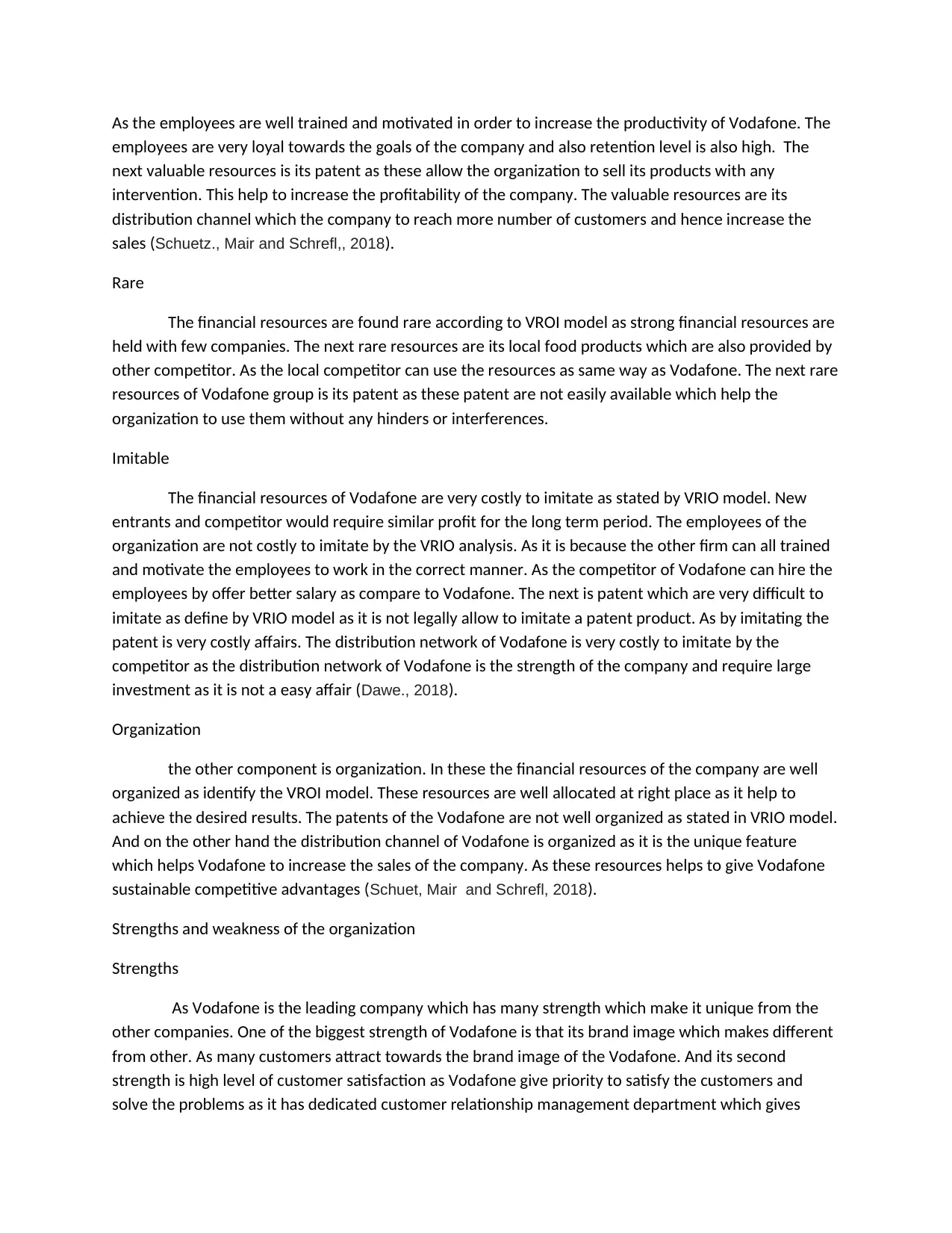
As the employees are well trained and motivated in order to increase the productivity of Vodafone. The
employees are very loyal towards the goals of the company and also retention level is also high. The
next valuable resources is its patent as these allow the organization to sell its products with any
intervention. This help to increase the profitability of the company. The valuable resources are its
distribution channel which the company to reach more number of customers and hence increase the
sales (Schuetz., Mair and Schrefl,, 2018).
Rare
The financial resources are found rare according to VROI model as strong financial resources are
held with few companies. The next rare resources are its local food products which are also provided by
other competitor. As the local competitor can use the resources as same way as Vodafone. The next rare
resources of Vodafone group is its patent as these patent are not easily available which help the
organization to use them without any hinders or interferences.
Imitable
The financial resources of Vodafone are very costly to imitate as stated by VRIO model. New
entrants and competitor would require similar profit for the long term period. The employees of the
organization are not costly to imitate by the VRIO analysis. As it is because the other firm can all trained
and motivate the employees to work in the correct manner. As the competitor of Vodafone can hire the
employees by offer better salary as compare to Vodafone. The next is patent which are very difficult to
imitate as define by VRIO model as it is not legally allow to imitate a patent product. As by imitating the
patent is very costly affairs. The distribution network of Vodafone is very costly to imitate by the
competitor as the distribution network of Vodafone is the strength of the company and require large
investment as it is not a easy affair (Dawe., 2018).
Organization
the other component is organization. In these the financial resources of the company are well
organized as identify the VROI model. These resources are well allocated at right place as it help to
achieve the desired results. The patents of the Vodafone are not well organized as stated in VRIO model.
And on the other hand the distribution channel of Vodafone is organized as it is the unique feature
which helps Vodafone to increase the sales of the company. As these resources helps to give Vodafone
sustainable competitive advantages (Schuet, Mair and Schrefl, 2018).
Strengths and weakness of the organization
Strengths
As Vodafone is the leading company which has many strength which make it unique from the
other companies. One of the biggest strength of Vodafone is that its brand image which makes different
from other. As many customers attract towards the brand image of the Vodafone. And its second
strength is high level of customer satisfaction as Vodafone give priority to satisfy the customers and
solve the problems as it has dedicated customer relationship management department which gives
employees are very loyal towards the goals of the company and also retention level is also high. The
next valuable resources is its patent as these allow the organization to sell its products with any
intervention. This help to increase the profitability of the company. The valuable resources are its
distribution channel which the company to reach more number of customers and hence increase the
sales (Schuetz., Mair and Schrefl,, 2018).
Rare
The financial resources are found rare according to VROI model as strong financial resources are
held with few companies. The next rare resources are its local food products which are also provided by
other competitor. As the local competitor can use the resources as same way as Vodafone. The next rare
resources of Vodafone group is its patent as these patent are not easily available which help the
organization to use them without any hinders or interferences.
Imitable
The financial resources of Vodafone are very costly to imitate as stated by VRIO model. New
entrants and competitor would require similar profit for the long term period. The employees of the
organization are not costly to imitate by the VRIO analysis. As it is because the other firm can all trained
and motivate the employees to work in the correct manner. As the competitor of Vodafone can hire the
employees by offer better salary as compare to Vodafone. The next is patent which are very difficult to
imitate as define by VRIO model as it is not legally allow to imitate a patent product. As by imitating the
patent is very costly affairs. The distribution network of Vodafone is very costly to imitate by the
competitor as the distribution network of Vodafone is the strength of the company and require large
investment as it is not a easy affair (Dawe., 2018).
Organization
the other component is organization. In these the financial resources of the company are well
organized as identify the VROI model. These resources are well allocated at right place as it help to
achieve the desired results. The patents of the Vodafone are not well organized as stated in VRIO model.
And on the other hand the distribution channel of Vodafone is organized as it is the unique feature
which helps Vodafone to increase the sales of the company. As these resources helps to give Vodafone
sustainable competitive advantages (Schuet, Mair and Schrefl, 2018).
Strengths and weakness of the organization
Strengths
As Vodafone is the leading company which has many strength which make it unique from the
other companies. One of the biggest strength of Vodafone is that its brand image which makes different
from other. As many customers attract towards the brand image of the Vodafone. And its second
strength is high level of customer satisfaction as Vodafone give priority to satisfy the customers and
solve the problems as it has dedicated customer relationship management department which gives
⊘ This is a preview!⊘
Do you want full access?
Subscribe today to unlock all pages.

Trusted by 1+ million students worldwide
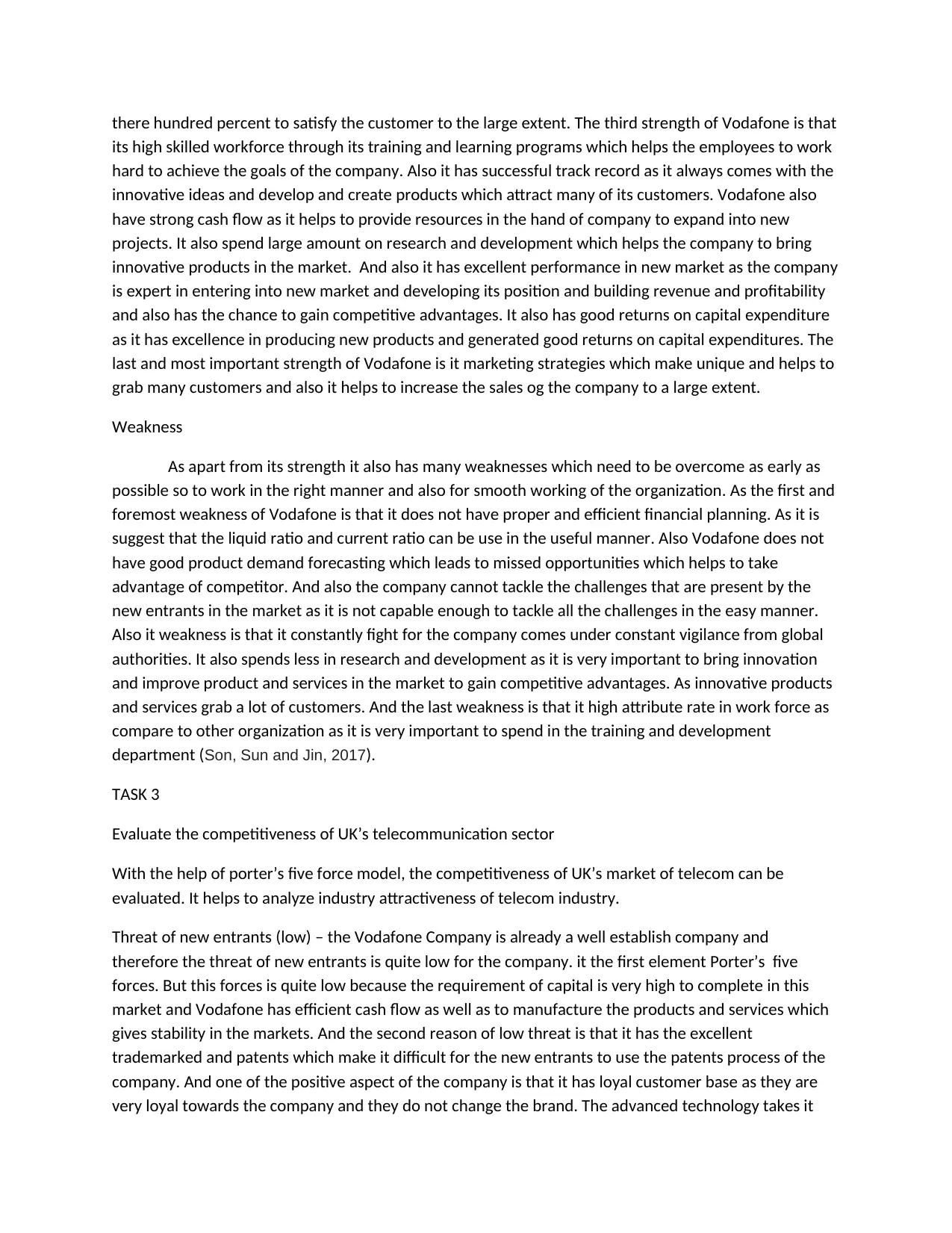
there hundred percent to satisfy the customer to the large extent. The third strength of Vodafone is that
its high skilled workforce through its training and learning programs which helps the employees to work
hard to achieve the goals of the company. Also it has successful track record as it always comes with the
innovative ideas and develop and create products which attract many of its customers. Vodafone also
have strong cash flow as it helps to provide resources in the hand of company to expand into new
projects. It also spend large amount on research and development which helps the company to bring
innovative products in the market. And also it has excellent performance in new market as the company
is expert in entering into new market and developing its position and building revenue and profitability
and also has the chance to gain competitive advantages. It also has good returns on capital expenditure
as it has excellence in producing new products and generated good returns on capital expenditures. The
last and most important strength of Vodafone is it marketing strategies which make unique and helps to
grab many customers and also it helps to increase the sales og the company to a large extent.
Weakness
As apart from its strength it also has many weaknesses which need to be overcome as early as
possible so to work in the right manner and also for smooth working of the organization. As the first and
foremost weakness of Vodafone is that it does not have proper and efficient financial planning. As it is
suggest that the liquid ratio and current ratio can be use in the useful manner. Also Vodafone does not
have good product demand forecasting which leads to missed opportunities which helps to take
advantage of competitor. And also the company cannot tackle the challenges that are present by the
new entrants in the market as it is not capable enough to tackle all the challenges in the easy manner.
Also it weakness is that it constantly fight for the company comes under constant vigilance from global
authorities. It also spends less in research and development as it is very important to bring innovation
and improve product and services in the market to gain competitive advantages. As innovative products
and services grab a lot of customers. And the last weakness is that it high attribute rate in work force as
compare to other organization as it is very important to spend in the training and development
department (Son, Sun and Jin, 2017).
TASK 3
Evaluate the competitiveness of UK’s telecommunication sector
With the help of porter’s five force model, the competitiveness of UK’s market of telecom can be
evaluated. It helps to analyze industry attractiveness of telecom industry.
Threat of new entrants (low) – the Vodafone Company is already a well establish company and
therefore the threat of new entrants is quite low for the company. it the first element Porter’s five
forces. But this forces is quite low because the requirement of capital is very high to complete in this
market and Vodafone has efficient cash flow as well as to manufacture the products and services which
gives stability in the markets. And the second reason of low threat is that it has the excellent
trademarked and patents which make it difficult for the new entrants to use the patents process of the
company. And one of the positive aspect of the company is that it has loyal customer base as they are
very loyal towards the company and they do not change the brand. The advanced technology takes it
its high skilled workforce through its training and learning programs which helps the employees to work
hard to achieve the goals of the company. Also it has successful track record as it always comes with the
innovative ideas and develop and create products which attract many of its customers. Vodafone also
have strong cash flow as it helps to provide resources in the hand of company to expand into new
projects. It also spend large amount on research and development which helps the company to bring
innovative products in the market. And also it has excellent performance in new market as the company
is expert in entering into new market and developing its position and building revenue and profitability
and also has the chance to gain competitive advantages. It also has good returns on capital expenditure
as it has excellence in producing new products and generated good returns on capital expenditures. The
last and most important strength of Vodafone is it marketing strategies which make unique and helps to
grab many customers and also it helps to increase the sales og the company to a large extent.
Weakness
As apart from its strength it also has many weaknesses which need to be overcome as early as
possible so to work in the right manner and also for smooth working of the organization. As the first and
foremost weakness of Vodafone is that it does not have proper and efficient financial planning. As it is
suggest that the liquid ratio and current ratio can be use in the useful manner. Also Vodafone does not
have good product demand forecasting which leads to missed opportunities which helps to take
advantage of competitor. And also the company cannot tackle the challenges that are present by the
new entrants in the market as it is not capable enough to tackle all the challenges in the easy manner.
Also it weakness is that it constantly fight for the company comes under constant vigilance from global
authorities. It also spends less in research and development as it is very important to bring innovation
and improve product and services in the market to gain competitive advantages. As innovative products
and services grab a lot of customers. And the last weakness is that it high attribute rate in work force as
compare to other organization as it is very important to spend in the training and development
department (Son, Sun and Jin, 2017).
TASK 3
Evaluate the competitiveness of UK’s telecommunication sector
With the help of porter’s five force model, the competitiveness of UK’s market of telecom can be
evaluated. It helps to analyze industry attractiveness of telecom industry.
Threat of new entrants (low) – the Vodafone Company is already a well establish company and
therefore the threat of new entrants is quite low for the company. it the first element Porter’s five
forces. But this forces is quite low because the requirement of capital is very high to complete in this
market and Vodafone has efficient cash flow as well as to manufacture the products and services which
gives stability in the markets. And the second reason of low threat is that it has the excellent
trademarked and patents which make it difficult for the new entrants to use the patents process of the
company. And one of the positive aspect of the company is that it has loyal customer base as they are
very loyal towards the company and they do not change the brand. The advanced technology takes it
Paraphrase This Document
Need a fresh take? Get an instant paraphrase of this document with our AI Paraphraser
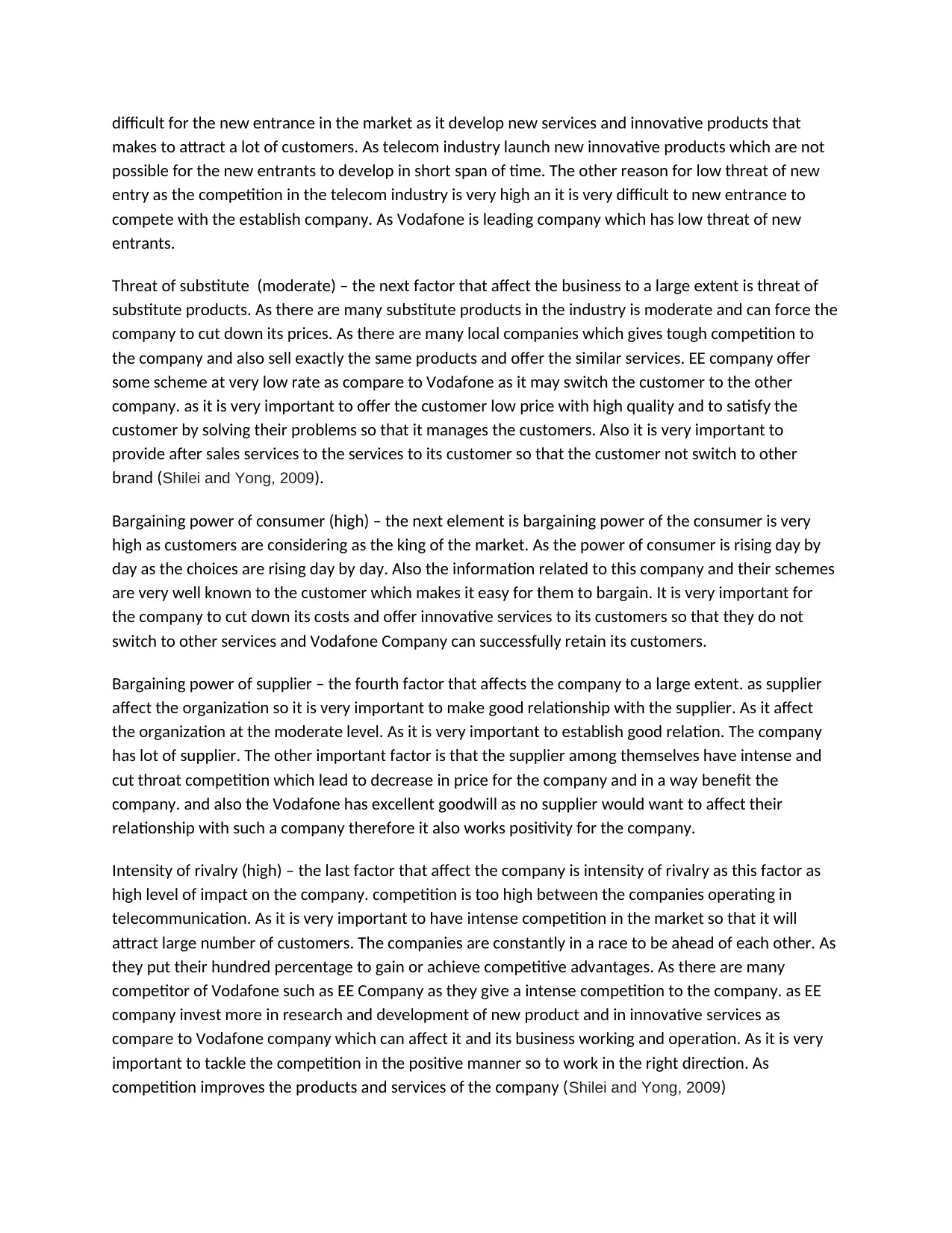
difficult for the new entrance in the market as it develop new services and innovative products that
makes to attract a lot of customers. As telecom industry launch new innovative products which are not
possible for the new entrants to develop in short span of time. The other reason for low threat of new
entry as the competition in the telecom industry is very high an it is very difficult to new entrance to
compete with the establish company. As Vodafone is leading company which has low threat of new
entrants.
Threat of substitute (moderate) – the next factor that affect the business to a large extent is threat of
substitute products. As there are many substitute products in the industry is moderate and can force the
company to cut down its prices. As there are many local companies which gives tough competition to
the company and also sell exactly the same products and offer the similar services. EE company offer
some scheme at very low rate as compare to Vodafone as it may switch the customer to the other
company. as it is very important to offer the customer low price with high quality and to satisfy the
customer by solving their problems so that it manages the customers. Also it is very important to
provide after sales services to the services to its customer so that the customer not switch to other
brand (Shilei and Yong, 2009).
Bargaining power of consumer (high) – the next element is bargaining power of the consumer is very
high as customers are considering as the king of the market. As the power of consumer is rising day by
day as the choices are rising day by day. Also the information related to this company and their schemes
are very well known to the customer which makes it easy for them to bargain. It is very important for
the company to cut down its costs and offer innovative services to its customers so that they do not
switch to other services and Vodafone Company can successfully retain its customers.
Bargaining power of supplier – the fourth factor that affects the company to a large extent. as supplier
affect the organization so it is very important to make good relationship with the supplier. As it affect
the organization at the moderate level. As it is very important to establish good relation. The company
has lot of supplier. The other important factor is that the supplier among themselves have intense and
cut throat competition which lead to decrease in price for the company and in a way benefit the
company. and also the Vodafone has excellent goodwill as no supplier would want to affect their
relationship with such a company therefore it also works positivity for the company.
Intensity of rivalry (high) – the last factor that affect the company is intensity of rivalry as this factor as
high level of impact on the company. competition is too high between the companies operating in
telecommunication. As it is very important to have intense competition in the market so that it will
attract large number of customers. The companies are constantly in a race to be ahead of each other. As
they put their hundred percentage to gain or achieve competitive advantages. As there are many
competitor of Vodafone such as EE Company as they give a intense competition to the company. as EE
company invest more in research and development of new product and in innovative services as
compare to Vodafone company which can affect it and its business working and operation. As it is very
important to tackle the competition in the positive manner so to work in the right direction. As
competition improves the products and services of the company (Shilei and Yong, 2009)
makes to attract a lot of customers. As telecom industry launch new innovative products which are not
possible for the new entrants to develop in short span of time. The other reason for low threat of new
entry as the competition in the telecom industry is very high an it is very difficult to new entrance to
compete with the establish company. As Vodafone is leading company which has low threat of new
entrants.
Threat of substitute (moderate) – the next factor that affect the business to a large extent is threat of
substitute products. As there are many substitute products in the industry is moderate and can force the
company to cut down its prices. As there are many local companies which gives tough competition to
the company and also sell exactly the same products and offer the similar services. EE company offer
some scheme at very low rate as compare to Vodafone as it may switch the customer to the other
company. as it is very important to offer the customer low price with high quality and to satisfy the
customer by solving their problems so that it manages the customers. Also it is very important to
provide after sales services to the services to its customer so that the customer not switch to other
brand (Shilei and Yong, 2009).
Bargaining power of consumer (high) – the next element is bargaining power of the consumer is very
high as customers are considering as the king of the market. As the power of consumer is rising day by
day as the choices are rising day by day. Also the information related to this company and their schemes
are very well known to the customer which makes it easy for them to bargain. It is very important for
the company to cut down its costs and offer innovative services to its customers so that they do not
switch to other services and Vodafone Company can successfully retain its customers.
Bargaining power of supplier – the fourth factor that affects the company to a large extent. as supplier
affect the organization so it is very important to make good relationship with the supplier. As it affect
the organization at the moderate level. As it is very important to establish good relation. The company
has lot of supplier. The other important factor is that the supplier among themselves have intense and
cut throat competition which lead to decrease in price for the company and in a way benefit the
company. and also the Vodafone has excellent goodwill as no supplier would want to affect their
relationship with such a company therefore it also works positivity for the company.
Intensity of rivalry (high) – the last factor that affect the company is intensity of rivalry as this factor as
high level of impact on the company. competition is too high between the companies operating in
telecommunication. As it is very important to have intense competition in the market so that it will
attract large number of customers. The companies are constantly in a race to be ahead of each other. As
they put their hundred percentage to gain or achieve competitive advantages. As there are many
competitor of Vodafone such as EE Company as they give a intense competition to the company. as EE
company invest more in research and development of new product and in innovative services as
compare to Vodafone company which can affect it and its business working and operation. As it is very
important to tackle the competition in the positive manner so to work in the right direction. As
competition improves the products and services of the company (Shilei and Yong, 2009)
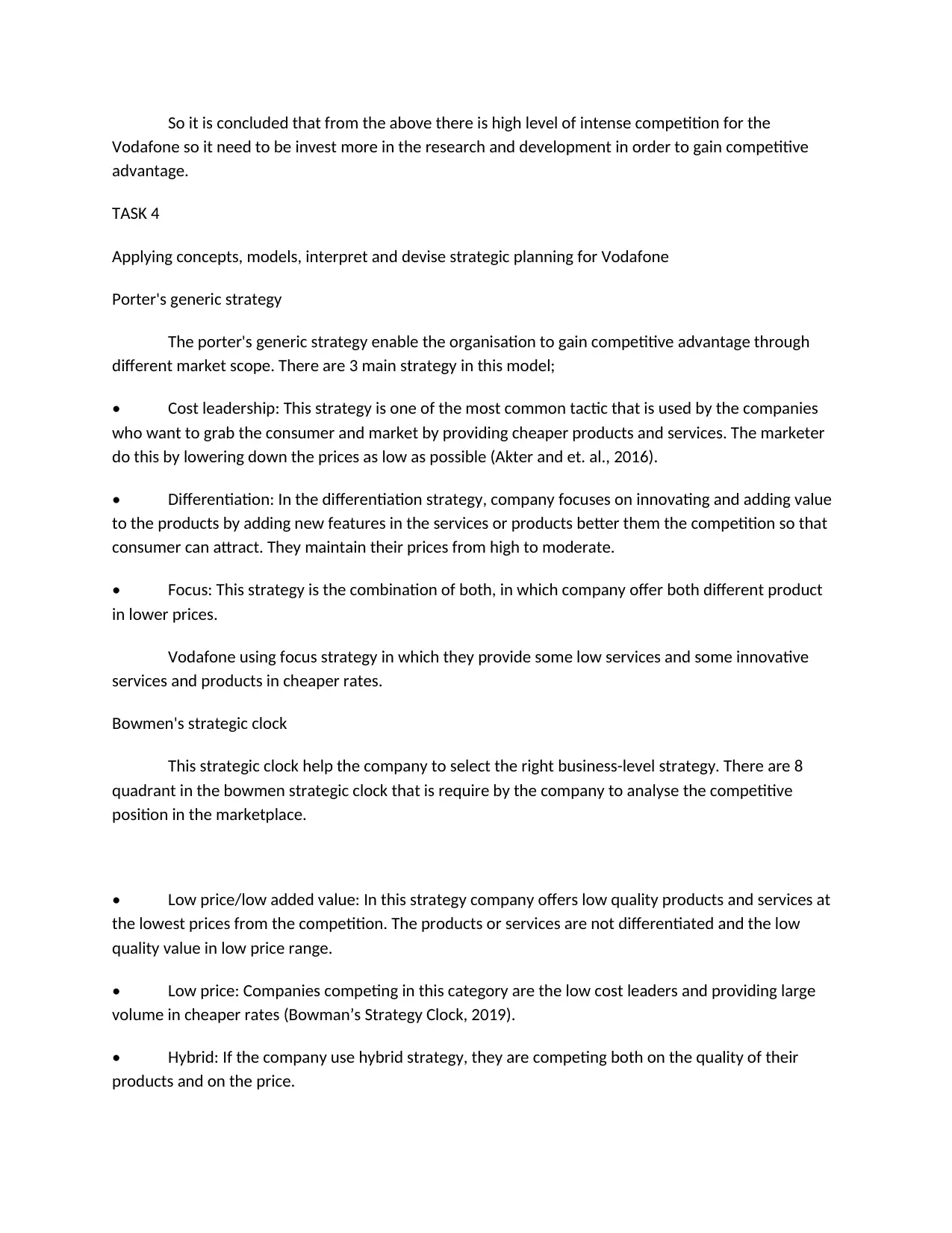
So it is concluded that from the above there is high level of intense competition for the
Vodafone so it need to be invest more in the research and development in order to gain competitive
advantage.
TASK 4
Applying concepts, models, interpret and devise strategic planning for Vodafone
Porter's generic strategy
The porter's generic strategy enable the organisation to gain competitive advantage through
different market scope. There are 3 main strategy in this model;
• Cost leadership: This strategy is one of the most common tactic that is used by the companies
who want to grab the consumer and market by providing cheaper products and services. The marketer
do this by lowering down the prices as low as possible (Akter and et. al., 2016).
• Differentiation: In the differentiation strategy, company focuses on innovating and adding value
to the products by adding new features in the services or products better them the competition so that
consumer can attract. They maintain their prices from high to moderate.
• Focus: This strategy is the combination of both, in which company offer both different product
in lower prices.
Vodafone using focus strategy in which they provide some low services and some innovative
services and products in cheaper rates.
Bowmen's strategic clock
This strategic clock help the company to select the right business-level strategy. There are 8
quadrant in the bowmen strategic clock that is require by the company to analyse the competitive
position in the marketplace.
• Low price/low added value: In this strategy company offers low quality products and services at
the lowest prices from the competition. The products or services are not differentiated and the low
quality value in low price range.
• Low price: Companies competing in this category are the low cost leaders and providing large
volume in cheaper rates (Bowman’s Strategy Clock, 2019).
• Hybrid: If the company use hybrid strategy, they are competing both on the quality of their
products and on the price.
Vodafone so it need to be invest more in the research and development in order to gain competitive
advantage.
TASK 4
Applying concepts, models, interpret and devise strategic planning for Vodafone
Porter's generic strategy
The porter's generic strategy enable the organisation to gain competitive advantage through
different market scope. There are 3 main strategy in this model;
• Cost leadership: This strategy is one of the most common tactic that is used by the companies
who want to grab the consumer and market by providing cheaper products and services. The marketer
do this by lowering down the prices as low as possible (Akter and et. al., 2016).
• Differentiation: In the differentiation strategy, company focuses on innovating and adding value
to the products by adding new features in the services or products better them the competition so that
consumer can attract. They maintain their prices from high to moderate.
• Focus: This strategy is the combination of both, in which company offer both different product
in lower prices.
Vodafone using focus strategy in which they provide some low services and some innovative
services and products in cheaper rates.
Bowmen's strategic clock
This strategic clock help the company to select the right business-level strategy. There are 8
quadrant in the bowmen strategic clock that is require by the company to analyse the competitive
position in the marketplace.
• Low price/low added value: In this strategy company offers low quality products and services at
the lowest prices from the competition. The products or services are not differentiated and the low
quality value in low price range.
• Low price: Companies competing in this category are the low cost leaders and providing large
volume in cheaper rates (Bowman’s Strategy Clock, 2019).
• Hybrid: If the company use hybrid strategy, they are competing both on the quality of their
products and on the price.
⊘ This is a preview!⊘
Do you want full access?
Subscribe today to unlock all pages.

Trusted by 1+ million students worldwide
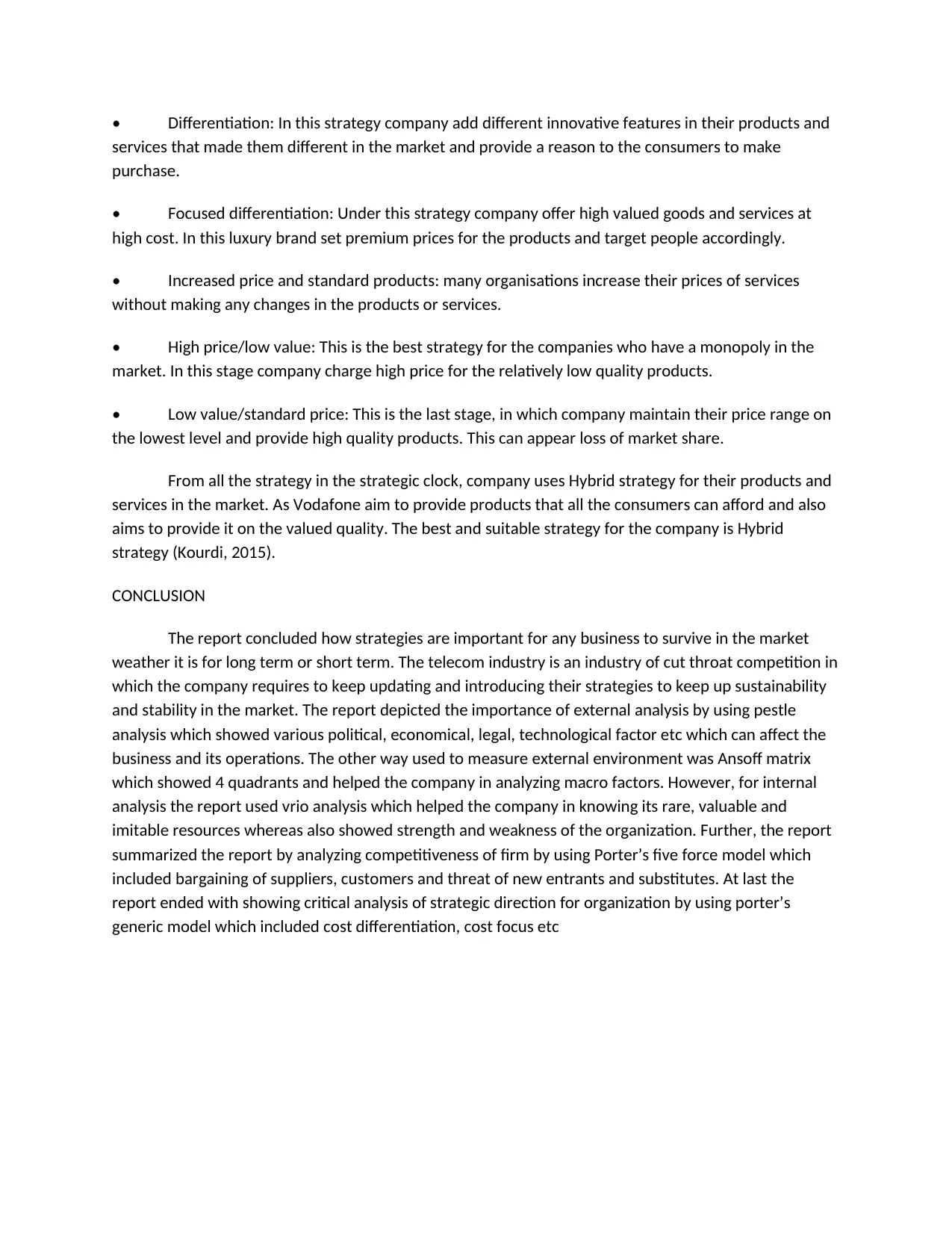
• Differentiation: In this strategy company add different innovative features in their products and
services that made them different in the market and provide a reason to the consumers to make
purchase.
• Focused differentiation: Under this strategy company offer high valued goods and services at
high cost. In this luxury brand set premium prices for the products and target people accordingly.
• Increased price and standard products: many organisations increase their prices of services
without making any changes in the products or services.
• High price/low value: This is the best strategy for the companies who have a monopoly in the
market. In this stage company charge high price for the relatively low quality products.
• Low value/standard price: This is the last stage, in which company maintain their price range on
the lowest level and provide high quality products. This can appear loss of market share.
From all the strategy in the strategic clock, company uses Hybrid strategy for their products and
services in the market. As Vodafone aim to provide products that all the consumers can afford and also
aims to provide it on the valued quality. The best and suitable strategy for the company is Hybrid
strategy (Kourdi, 2015).
CONCLUSION
The report concluded how strategies are important for any business to survive in the market
weather it is for long term or short term. The telecom industry is an industry of cut throat competition in
which the company requires to keep updating and introducing their strategies to keep up sustainability
and stability in the market. The report depicted the importance of external analysis by using pestle
analysis which showed various political, economical, legal, technological factor etc which can affect the
business and its operations. The other way used to measure external environment was Ansoff matrix
which showed 4 quadrants and helped the company in analyzing macro factors. However, for internal
analysis the report used vrio analysis which helped the company in knowing its rare, valuable and
imitable resources whereas also showed strength and weakness of the organization. Further, the report
summarized the report by analyzing competitiveness of firm by using Porter’s five force model which
included bargaining of suppliers, customers and threat of new entrants and substitutes. At last the
report ended with showing critical analysis of strategic direction for organization by using porter’s
generic model which included cost differentiation, cost focus etc
services that made them different in the market and provide a reason to the consumers to make
purchase.
• Focused differentiation: Under this strategy company offer high valued goods and services at
high cost. In this luxury brand set premium prices for the products and target people accordingly.
• Increased price and standard products: many organisations increase their prices of services
without making any changes in the products or services.
• High price/low value: This is the best strategy for the companies who have a monopoly in the
market. In this stage company charge high price for the relatively low quality products.
• Low value/standard price: This is the last stage, in which company maintain their price range on
the lowest level and provide high quality products. This can appear loss of market share.
From all the strategy in the strategic clock, company uses Hybrid strategy for their products and
services in the market. As Vodafone aim to provide products that all the consumers can afford and also
aims to provide it on the valued quality. The best and suitable strategy for the company is Hybrid
strategy (Kourdi, 2015).
CONCLUSION
The report concluded how strategies are important for any business to survive in the market
weather it is for long term or short term. The telecom industry is an industry of cut throat competition in
which the company requires to keep updating and introducing their strategies to keep up sustainability
and stability in the market. The report depicted the importance of external analysis by using pestle
analysis which showed various political, economical, legal, technological factor etc which can affect the
business and its operations. The other way used to measure external environment was Ansoff matrix
which showed 4 quadrants and helped the company in analyzing macro factors. However, for internal
analysis the report used vrio analysis which helped the company in knowing its rare, valuable and
imitable resources whereas also showed strength and weakness of the organization. Further, the report
summarized the report by analyzing competitiveness of firm by using Porter’s five force model which
included bargaining of suppliers, customers and threat of new entrants and substitutes. At last the
report ended with showing critical analysis of strategic direction for organization by using porter’s
generic model which included cost differentiation, cost focus etc
Paraphrase This Document
Need a fresh take? Get an instant paraphrase of this document with our AI Paraphraser
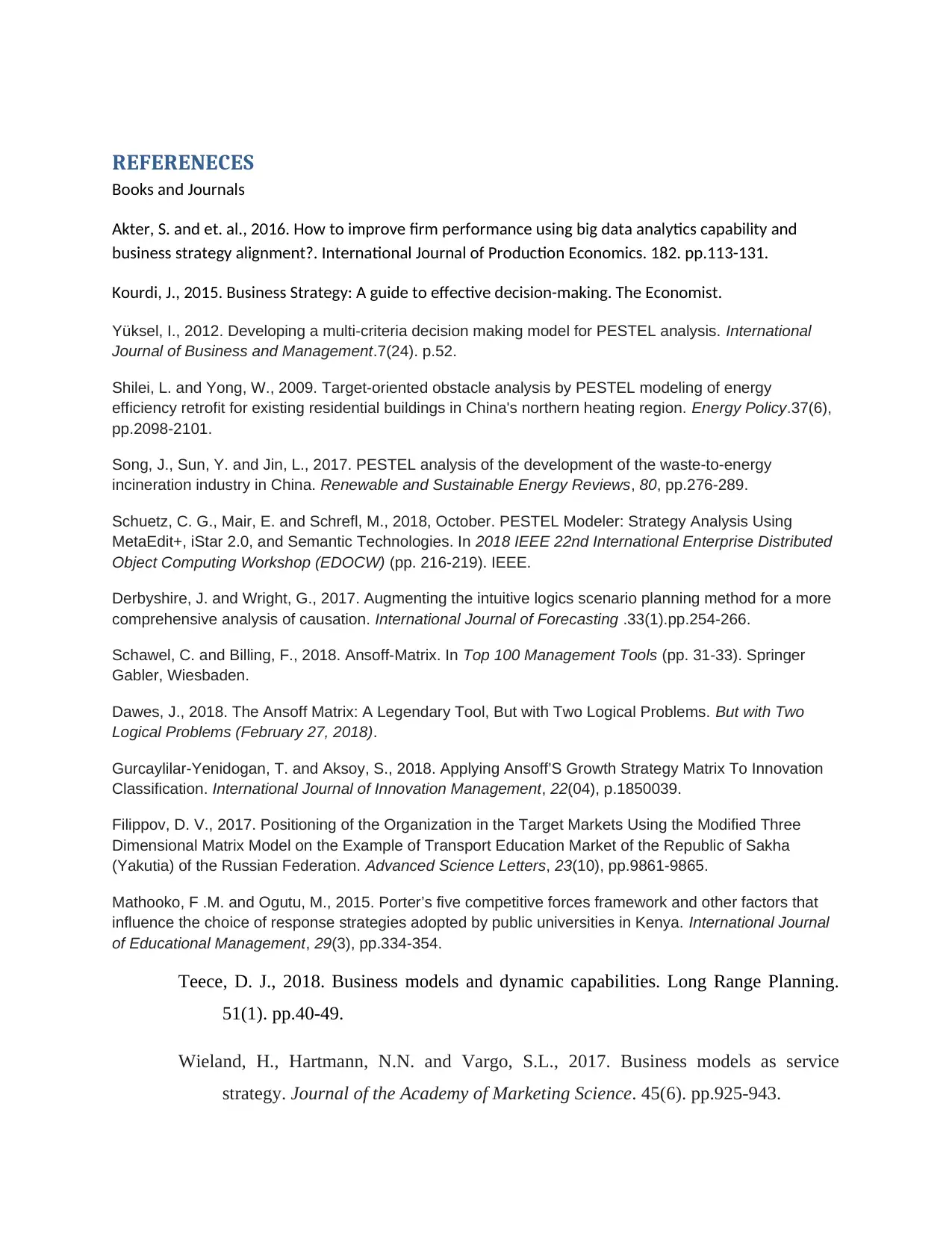
REFERENECES
Books and Journals
Akter, S. and et. al., 2016. How to improve firm performance using big data analytics capability and
business strategy alignment?. International Journal of Production Economics. 182. pp.113-131.
Kourdi, J., 2015. Business Strategy: A guide to effective decision-making. The Economist.
Yüksel, I., 2012. Developing a multi-criteria decision making model for PESTEL analysis. International
Journal of Business and Management.7(24). p.52.
Shilei, L. and Yong, W., 2009. Target-oriented obstacle analysis by PESTEL modeling of energy
efficiency retrofit for existing residential buildings in China's northern heating region. Energy Policy.37(6),
pp.2098-2101.
Song, J., Sun, Y. and Jin, L., 2017. PESTEL analysis of the development of the waste-to-energy
incineration industry in China. Renewable and Sustainable Energy Reviews, 80, pp.276-289.
Schuetz, C. G., Mair, E. and Schrefl, M., 2018, October. PESTEL Modeler: Strategy Analysis Using
MetaEdit+, iStar 2.0, and Semantic Technologies. In 2018 IEEE 22nd International Enterprise Distributed
Object Computing Workshop (EDOCW) (pp. 216-219). IEEE.
Derbyshire, J. and Wright, G., 2017. Augmenting the intuitive logics scenario planning method for a more
comprehensive analysis of causation. International Journal of Forecasting .33(1).pp.254-266.
Schawel, C. and Billing, F., 2018. Ansoff-Matrix. In Top 100 Management Tools (pp. 31-33). Springer
Gabler, Wiesbaden.
Dawes, J., 2018. The Ansoff Matrix: A Legendary Tool, But with Two Logical Problems. But with Two
Logical Problems (February 27, 2018).
Gurcaylilar-Yenidogan, T. and Aksoy, S., 2018. Applying Ansoff’S Growth Strategy Matrix To Innovation
Classification. International Journal of Innovation Management, 22(04), p.1850039.
Filippov, D. V., 2017. Positioning of the Organization in the Target Markets Using the Modified Three
Dimensional Matrix Model on the Example of Transport Education Market of the Republic of Sakha
(Yakutia) of the Russian Federation. Advanced Science Letters, 23(10), pp.9861-9865.
Mathooko, F .M. and Ogutu, M., 2015. Porter’s five competitive forces framework and other factors that
influence the choice of response strategies adopted by public universities in Kenya. International Journal
of Educational Management, 29(3), pp.334-354.
Teece, D. J., 2018. Business models and dynamic capabilities. Long Range Planning.
51(1). pp.40-49.
Wieland, H., Hartmann, N.N. and Vargo, S.L., 2017. Business models as service
strategy. Journal of the Academy of Marketing Science. 45(6). pp.925-943.
Books and Journals
Akter, S. and et. al., 2016. How to improve firm performance using big data analytics capability and
business strategy alignment?. International Journal of Production Economics. 182. pp.113-131.
Kourdi, J., 2015. Business Strategy: A guide to effective decision-making. The Economist.
Yüksel, I., 2012. Developing a multi-criteria decision making model for PESTEL analysis. International
Journal of Business and Management.7(24). p.52.
Shilei, L. and Yong, W., 2009. Target-oriented obstacle analysis by PESTEL modeling of energy
efficiency retrofit for existing residential buildings in China's northern heating region. Energy Policy.37(6),
pp.2098-2101.
Song, J., Sun, Y. and Jin, L., 2017. PESTEL analysis of the development of the waste-to-energy
incineration industry in China. Renewable and Sustainable Energy Reviews, 80, pp.276-289.
Schuetz, C. G., Mair, E. and Schrefl, M., 2018, October. PESTEL Modeler: Strategy Analysis Using
MetaEdit+, iStar 2.0, and Semantic Technologies. In 2018 IEEE 22nd International Enterprise Distributed
Object Computing Workshop (EDOCW) (pp. 216-219). IEEE.
Derbyshire, J. and Wright, G., 2017. Augmenting the intuitive logics scenario planning method for a more
comprehensive analysis of causation. International Journal of Forecasting .33(1).pp.254-266.
Schawel, C. and Billing, F., 2018. Ansoff-Matrix. In Top 100 Management Tools (pp. 31-33). Springer
Gabler, Wiesbaden.
Dawes, J., 2018. The Ansoff Matrix: A Legendary Tool, But with Two Logical Problems. But with Two
Logical Problems (February 27, 2018).
Gurcaylilar-Yenidogan, T. and Aksoy, S., 2018. Applying Ansoff’S Growth Strategy Matrix To Innovation
Classification. International Journal of Innovation Management, 22(04), p.1850039.
Filippov, D. V., 2017. Positioning of the Organization in the Target Markets Using the Modified Three
Dimensional Matrix Model on the Example of Transport Education Market of the Republic of Sakha
(Yakutia) of the Russian Federation. Advanced Science Letters, 23(10), pp.9861-9865.
Mathooko, F .M. and Ogutu, M., 2015. Porter’s five competitive forces framework and other factors that
influence the choice of response strategies adopted by public universities in Kenya. International Journal
of Educational Management, 29(3), pp.334-354.
Teece, D. J., 2018. Business models and dynamic capabilities. Long Range Planning.
51(1). pp.40-49.
Wieland, H., Hartmann, N.N. and Vargo, S.L., 2017. Business models as service
strategy. Journal of the Academy of Marketing Science. 45(6). pp.925-943.
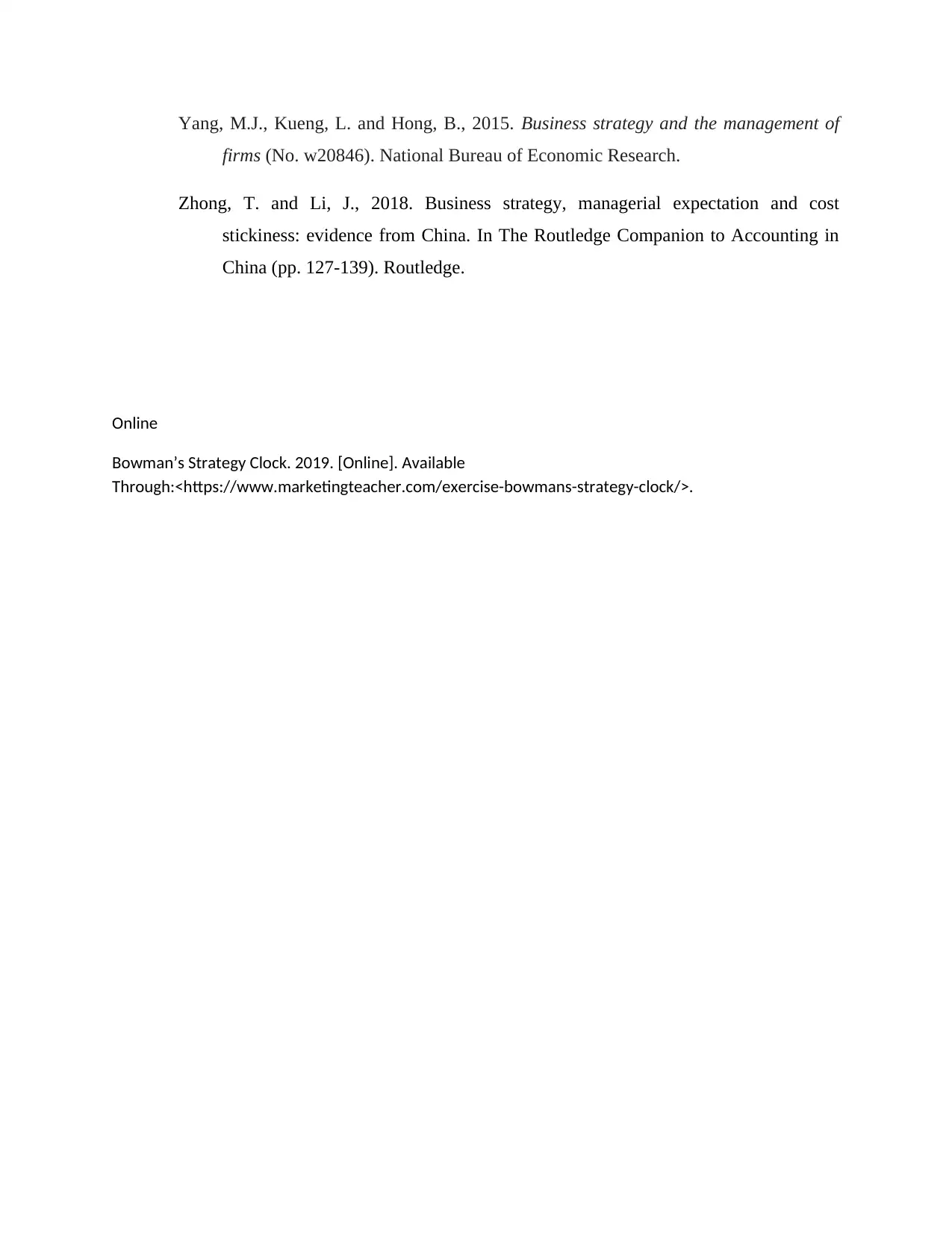
Yang, M.J., Kueng, L. and Hong, B., 2015. Business strategy and the management of
firms (No. w20846). National Bureau of Economic Research.
Zhong, T. and Li, J., 2018. Business strategy, managerial expectation and cost
stickiness: evidence from China. In The Routledge Companion to Accounting in
China (pp. 127-139). Routledge.
Online
Bowman’s Strategy Clock. 2019. [Online]. Available
Through:<https://www.marketingteacher.com/exercise-bowmans-strategy-clock/>.
firms (No. w20846). National Bureau of Economic Research.
Zhong, T. and Li, J., 2018. Business strategy, managerial expectation and cost
stickiness: evidence from China. In The Routledge Companion to Accounting in
China (pp. 127-139). Routledge.
Online
Bowman’s Strategy Clock. 2019. [Online]. Available
Through:<https://www.marketingteacher.com/exercise-bowmans-strategy-clock/>.
⊘ This is a preview!⊘
Do you want full access?
Subscribe today to unlock all pages.

Trusted by 1+ million students worldwide
1 out of 13
Related Documents
Your All-in-One AI-Powered Toolkit for Academic Success.
+13062052269
info@desklib.com
Available 24*7 on WhatsApp / Email
![[object Object]](/_next/static/media/star-bottom.7253800d.svg)
Unlock your academic potential
Copyright © 2020–2025 A2Z Services. All Rights Reserved. Developed and managed by ZUCOL.




